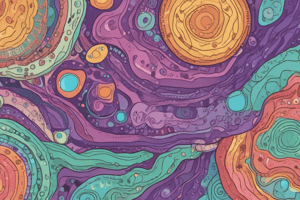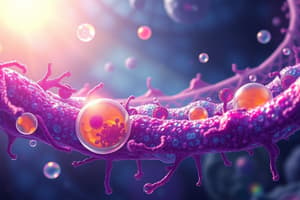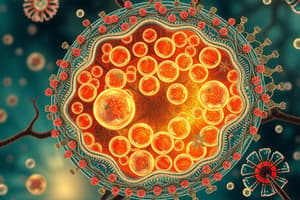Podcast
Questions and Answers
What is the primary function of the cell membrane?
What is the primary function of the cell membrane?
- To facilitate cell division
- To store genetic material
- To act as a barrier between the internal and external environment (correct)
- To provide energy to the cell
Cilia are longer than flagella and are responsible for moving the entire cell.
Cilia are longer than flagella and are responsible for moving the entire cell.
False (B)
What feature of the cell contains the genetic material of the cell?
What feature of the cell contains the genetic material of the cell?
Nucleus
The fluid mosaic model describes the structure of the cell membrane, which consists of a lipid __________.
The fluid mosaic model describes the structure of the cell membrane, which consists of a lipid __________.
Match the following structures with their primary functions:
Match the following structures with their primary functions:
What is the main function of the nucleolus?
What is the main function of the nucleolus?
The nuclear envelope is a single membrane separating the nucleus from the cytoplasm.
The nuclear envelope is a single membrane separating the nucleus from the cytoplasm.
What are the functions of lysosomes?
What are the functions of lysosomes?
Mitochondria are known as the __________ of the cell due to their function in generating ATP.
Mitochondria are known as the __________ of the cell due to their function in generating ATP.
Match the following organelles with their primary functions:
Match the following organelles with their primary functions:
Which filament is described as a flexible chain of actin molecules?
Which filament is described as a flexible chain of actin molecules?
The rough endoplasmic reticulum (ER) has ribosomes on its surface.
The rough endoplasmic reticulum (ER) has ribosomes on its surface.
What is the function of microtubules?
What is the function of microtubules?
Study Notes
Cell Structure and Function
- Cell membrane acts as a boundary, separating internal from external environments and serving as a selective barrier.
- Provides structural shape and aids in cellular communication.
Components of Cell Membrane
- Mucopolysaccharide/carbohydrate layer provides support.
- Outer proteins function as antigens and receptor sites.
- Lipid bilayer, integral to the fluid mosaic model, consists of polar heads and nonpolar tails.
- Additional components include phospholipids, cholesterol, glycolipids, and inner protein layer with channels/pores and transporters.
Cellular Projections
- Cilia are short, hair-like projections that help move fluids across the cell surface.
- Flagella are longer projections that enable the movement of entire cells; sperm cells are a notable example.
Nucleus
- Typically contains one nucleus per cell, excluding red blood cells and platelets; muscles are multinucleated.
- Nucleus houses genetic material (DNA) and regulates all metabolic activities.
- Chromosomes are comprised of DNA and packaging proteins, containing thousands of genes.
- Nucleolus is involved in ribosome synthesis and regulation of cell division.
- Nuclear envelope, a double membrane, separates the nucleus from the cytoplasm, with nuclear pores facilitating selective transport.
Cytoplasm
- Encompasses all cellular content between the cell membrane and the nucleus, containing cytosol (fluid) and organelles.
- Cytosol is primarily water, and organelles perform specific functions supported by a network of protein filaments.
Filament Types
- Microfilaments made of actin provide flexibility.
- Intermediate filaments are ropelike, maintaining cell structure.
- Microtubules exhibit dynamic stability, continuously elongating and shortening.
Centrosome
- Found near the nucleus, centrosomes contain centrioles that regulate cell division.
Endoplasmic Reticulum (ER)
- Composed of a network of membranes; includes Rough ER (with ribosomes for protein production) and Smooth ER (synthesizes fatty acids, steroids, and detoxifies drugs).
Ribosomes
- Sites of protein synthesis, composed of ribosomal RNA (rRNA) and protein, can be bound (on Rough ER) or unbound (free in cytoplasm).
- Prokaryotes have 70s ribosomes; eukaryotes have 80s ribosomes.
Proteasome
- Barrel-shaped organelle composed of enzymes responsible for degrading proteins.
Golgi Apparatus
- Consists of 3-20 flattened membrane sacs (cisternae), serving as the primary site for cellular secretion packaging.
Lysosomes
- Vesicles from the Golgi complex containing powerful enzymes to breakdown waste and nutrients (autophagy and heterophagy mechanisms).
Peroxisomes
- Smaller than lysosomes, involved in detoxifying substances like alcohol, particularly abundant in liver cells.
Vesicles
- Membrane-bound sacs transporting various materials throughout the cell.
Mitochondria
- Double membrane-bound organelles with circular DNA, known as the powerhouse of the cell, primarily generating ATP.
- More abundant in highly active cells (muscles, liver, kidneys) and consist of cristae and a fluid-filled matrix.
Studying That Suits You
Use AI to generate personalized quizzes and flashcards to suit your learning preferences.
Description
This quiz covers key features of cell structure including the cell membrane and various organelles. You'll explore the functions of the cell membrane as a selective barrier, its composition, and the role of organelles within the cytoplasm. Test your knowledge of cellular components and their importance in maintaining life.




